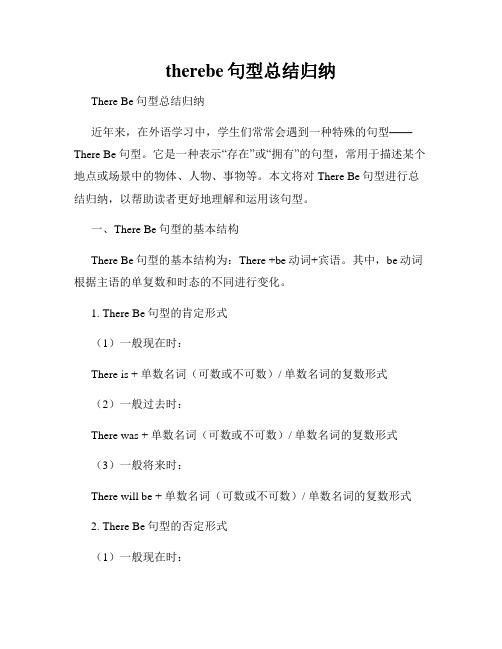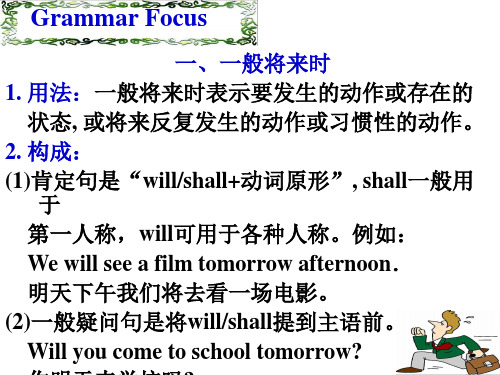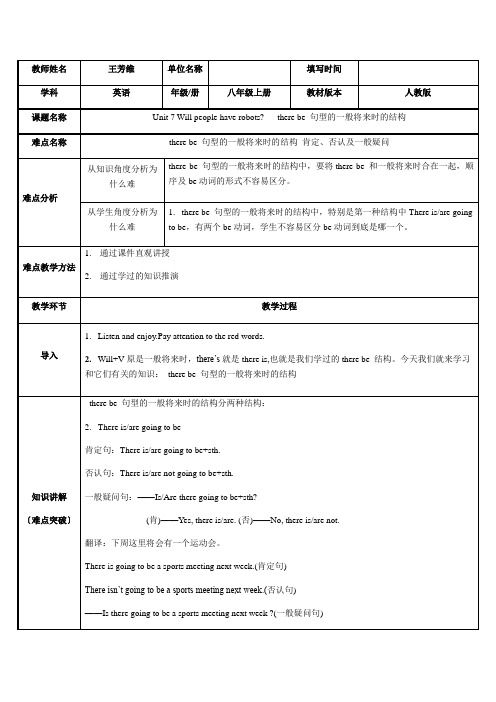最新there be句型的将来时结构
there be 句型一般将来时

there be 句型一般将来时今天咱们来一起学习there be句型的一般将来时呀。
There be句型一般将来时可有趣啦。
它有两种形式呢,一种是“there will be”,就像在说“将会有”。
比如说,咱们想象一下,明天是你的生日,你希望会有一个超级大的蛋糕。
那我们就可以说“There will be a big cake tomorrow.”是不是很简单呀?还有啊,假如你要去动物园,你觉得动物园里将会有很多可爱的小动物在等着你,你就可以说“There will be lots of lovely animals in the zoo.”另外一种形式是“there is/are going to be”。
这就像是在说“打算要有”或者“即将要有”。
我给你们讲个小故事吧。
有个小朋友叫小明,他的班级要开一个小小的植物展。
老师说在教室的角落里将会有很多漂亮的花朵。
那我们就可以说“There are going to be many beautiful flowers in the corner of the classroom.”小明可高兴啦,他想象着那些花朵五颜六色的样子,有红的像火一样的玫瑰,粉的像小姑娘脸蛋一样的康乃馨,还有黄的像小太阳一样的向日葵。
再比如说,咱们的学校要新建一个操场啦。
那我们就可以说“There is going to be a new playground in our school.”到时候呀,操场上将会有崭新的跑道,小朋友们可以在上面欢快地跑步。
还会有好多好玩的体育器材,像秋千呀,滑梯呀。
小朋友们就能在课间的时候尽情地玩耍啦。
还有呢,当春天要来了的时候,森林里将会有很多奇妙的变化。
There will be new leaves on the trees.(树上将会有新的叶子)那些新叶子嫩绿嫩绿的,就像一个个小耳朵在听着春天的声音。
There will be little birds building their nests.(将会有小鸟筑巢)小鸟们叽叽喳喳地,用小树枝和干草搭建着自己温暖的家。
There be 结构中的时态分析_

There be 结构中的时态分析_There be 结构中的时态分析1.There be 句型中动词be 可以有一般现在时、一般过去时、将来时和完成时。
一般现在时There is still room for improvement. 还有改进余地。
There is nothing to be done now. 现在没有办法了。
一般将来时There s going to be trouble. 要出事了。
There will be rain next week. 下星期要下雨。
一般过去时There was a lot to be done. 有很多事要做。
There wasn t any change in him. 他没有什么变化。
现在完成时There have been a lot of inquiries. 提出的询问有很多。
There have been a lot of enquiries. 进行过许多调查。
过去将来时There would be endless rows if I was at home. 如果我在家会有吵不完的架。
Then there would be a plebiscite. 那么就会举行公民投票。
2.There be 句型可以和各种助动词、情态动词连用。
There may be a cigarette in that box.那只盒子里或许有支香烟。
There must be some cakes on the table.桌子上一定有些蛋糕。
There used to be a hospital there before the war.战前,那里曾经有家医院。
3.There be 句型也可以和这样一些的谓语动词连用:be going to 、seem to 、appear to 、used to、be likely to 、happen to .There seem to be a few trees between me and the green.在我与草坪之间好像有一些树。
Therebe句型的一般将来时(讲义)人教PEP版英语六年级下册

There be句型的一般将来时一.定义:表示某地将有什么事情发生,一般与表示将来的时间连用,如tomorrow,tonight,next等。
意为“这儿将(没)有......”。
二.There be 句型的一般将来时的结构:(1)肯定句:① There is going to be + 其他① There will be + 其他【注意】这里的be永远不变,不可以改成is, am, are; 更不可以改为have.eg: There is going to be a basketball match this weekend.=There will be a basketball match this weekend.这个周末,这儿将有一场篮球比赛。
There is going to be an English test tomorrow.= There will be an English test tomorrow.明天将有一场英语考试。
(2)否定句:① There is + not + going to be + 其他(在is后面直接加not, 其他不变)① There will + not + be + 其他(在will 后面直接加not,其他不变) (will not = won’t)eg: There isn’t going to be a basketball match this weekend.=There won’t be a basketball match this weekend.这个周末,这儿将没有一场篮球比赛。
There isn’t going to be an English test tomorrow.= There won’t be an English test tomorrow.明天将没有一场英语考试。
(3)一般疑问句:① Is there going to be + 其他? (直接把is提前,其他不变,句末加上问号)① Will there be + 其他? (直接把will提前,其他不变,句末加上问号)eg: Is there going to be a basketball match this weekend?= Will there be a basketball match this weekend?( 这个周末将有一场篮球比赛吗?)Is there going to be an English test tomorrow?= Will there be an English test tomorrow?( 明天将有英语考试吗?)翻译下列句子.1.明天将有一场演唱会._________ __________ ____________ a concert(音乐会)__________._________ _________ __________ __________ ___________a concert(音乐会)__________.2.这儿将有一个好消息给你。
there be句型表将来的结构

there be句型表将来的结构There be句型表将来的结构。
一、基本结构。
1. There will be...- 这是最常见的表示将来的there be句型结构。
“will”是一般将来时的助动词,表示将来某个时间存在的人或事物。
- 例如:There will be a party in our school tomorrow.(明天我们学校将有一个聚会。
)在这个句子中,“will be”明确表示明天这个将来的时间会存在一个聚会这个事物。
2. There is/are going to be...- 这个结构也用于表示将来。
“be going to”通常表示根据目前的迹象、计划或意图即将发生某事。
- 例如:There are going to be some important meetings next week.(下周将有一些重要的会议。
)这里使用“are going to be”表示根据计划或者安排,下周会有会议。
如果主语是单数,就用“There is going to be”,例如:There is going to be a new movie on show this weekend.(这个周末将有一部新电影上映。
)二、结构区别与使用场景。
1. 区别。
- 含义侧重点。
- “There will be”更侧重于单纯地预测将来会发生的事情,没有特别强调计划或者事先的意图。
例如:There will be a lot of changes in the future.(未来会有很多变化。
)只是在预测未来会有变化,没有提及是否有计划。
- “There is/are going to be”往往带有一种根据现有情况或计划而做出的对将来的判断。
例如:Look at those dark clouds. There is going to be a storm.(看那些乌云。
即将有一场暴风雨。
will there be引导的一般将来时

我们除了用“be going to+动词原形”可以表示一般将来时外,我们还可以用“will+动词原形”来表示一般将来时.will 引导的一般将来时:表示将来发生的动作或存在的状态,最基本的结构:will + 动词原形“主谓(宾)句型”的一般将来时:肯定句:主语+ will +动词原形+(宾语)+其他Some day people will go to the moon .否定句:在will 的后面加not即可。
will not 可缩写为won’tThey won’t use books .一般疑问句:把will 提到句子主语之前,结尾变问号。
Will students go to school in the future ?特殊疑问句:特殊疑问词+will +主语+动词原形+其他What will your dream school have ?“There be”句型的一般将来时肯定句:There will be +名词+其他成份[注意]:无论后面加单数名词或复数形式,be都必须用原形。
There will be only one country.否定句:在will后面加not.There won’t be only one country.一般疑问句:把will提到there之前。
Will there be only one country?Yes, there will. / No, there won’t.注意:在口语中,所有人称都可以用will.一般将来时的主要用法:1、表示将来某一时刻的动作或状态:We will come to see you the day after tomorrow.There will be a wonderful show next week.2、表示将来某一段时间内经常的动作或状态:The students will come and work in the lab once a week.We will come and work in this factory every year.例句:1.I will call you this evening.2.Students will use computers to learn in the future.3.He will help his sister with her lessons.4.We won`t be free(空闲的)this afternoon.5.She will not listen to me.6.The birds won`t fly away to the south when the weather turns cold.7.There will be a strong wind soon.8.I will not tell it to him.9.I think it will be very hot in Beijing next summer.10.He will use his pen and his calculator.will句式总结:11.Will there be heavy rain and strong winds?一般将来时两种基本句式的区别:在初中阶段来讲,”be going to+动词原形”和“will+动词原形”这两种表示将来时态的结构没什么区别。
一般将来时,therebe句型的一般将来时

一般将来时的行为动词和非行为动词
行为动词和非行为动词在一般将来时中的使用是一样的。 行为动词示例:g o(去)、eat(吃)、run(跑) 非行为动词示例:believe(相信)、know(知道)、und erstand (理解)
一般将来时的祈使句和一般将来时的转换
祈使句表示请求、命令、建议等,一般将来时可以将祈使句转换为一般将来时来表示未来的动作。 例如: Open the window. → The window will be opened. Clean your room. → Your room will时间状语的使用
时间状语词可以在一般将来时中指定动作发生的时间,如to morrow(明天)、 next week(下周)、in the future(将来)、in a year(一年后)等。
一般将来时的动词的变化
一般将来时中,主语与动词之间不加任何变化,动词依然保持原形。 例如: I will travel to Paris next month. She will meet her friends for dinner tonight.
一般将来时 (Simple Future Tense) & There Be 句型的一般将来时 (Future Tense in There Be Sentences)
The Simple Future Tense
一般将来时的定义和基本结构
一般将来时(Sim p le Future Tense)表示将来某个时间要发生的动作或存在 的状态。 基本结构:主语 + will + 动词原形
一般将来时的否定形式和疑问形式
一般将来时的否定形式可以在will后添加not,疑问形式可以将will提到句首。 例如: I will not go to the party tonight. Will you attend the meeting tomorrow?
一般将来时therebe句型的一般将来时

用于表示对未 来的期望和愿 望,常与情态 动词be about to do sth连用
表示愿望和期望
可以用一般将 来时表示对未 来的愿望和期
望
可以用will+动 词原形表示对 未来的愿望和
期望
可以用be going to+动 词原形表示对 未来的愿望和
期望
可以用一般现 在时表示对未 来的愿望和期
望
其基本结构为 “there will be+主语+谓 语”,表示将来 某个时间点存在 的状态或发生的 事情。
在使用时应注意 时态的正确性, 与时间状语从句 的用法相结合, 以准确表达未来 的计划和安排。
可以通过与其他 时态的对比,强 调there be句 型的一般将来时 的特殊性和应用 场景。
04
强调句:there be句型的强调形 式
句型转换
陈述句转换为 疑问句:使用 be动词和助动 词do进行转换
肯定句转换为 否定句:在be
动词后面加 not或never
简单句转换为 复合句:使用 引导词和从句
进行转换
主动语态转换 为被动语态: 使用be动词和 过去分词进行
转换
02
一般将来时的基本用法
03
there be句型的一般将来时的用法
表示将来的存在
含义:表示将来某个时间点的存在 结构:There will be + 主语 + 谓语 用法:常用于描述未来的计划、预测或期望 例子:There will be a party next week.
表示将来的拥有
含义:表示将 来某个时间点 存在的状态或
拥有的物品
结构:there will be + 主
will、there be引导的一般将来时

我们除了用“be going to+动词原形”可以表示一般将来时外,我们还可以用“will+动词原形”来表示一般将来时.will 引导的一般将来时:表示将来发生的动作或存在的状态,最基本的结构:will + 动词原形“主谓(宾)句型”的一般将来时:肯定句:主语+ will +动词原形+(宾语)+其他Some day people will go to the moon .否定句:在will 的后面加not即可。
will not 可缩写为won’tThey won’t use books .一般疑问句:把will 提到句子主语之前,结尾变问号。
Will students go to school in the future ?特殊疑问句:特殊疑问词+will +主语+动词原形+其他?What will your dream school have ?“There be”句型的一般将来时肯定句:There will be +名词+其他成份[注意]:无论后面加单数名词或复数形式,be都必须用原形。
There will be only one country.否定句:在will后面加not.There won’t be only one country.一般疑问句:把will提到there之前。
Will there be only one country?Yes, there will. / No, there won’t.注意:在口语中,所有人称都可以用will.一般将来时的主要用法:1、表示将来某一时刻的动作或状态:We will come to see you the day after tomorrow.There will be a wonderful show next week.2、表示将来某一段时间内经常的动作或状态:The students will come and work in the lab once a week.We will come and work in this factory every year.例句:1.I will call you this evening.2.Students will use computers to learn in the future.3.He will help his sister with her lessons.4.We won`t be free(空闲的)this afternoon.5.She will not listen to me.6.The birds won`t fly away to the south when the weather turns cold.7.There will be a strong wind soon.8.I will not tell it to him.9.I think it will be very hot in Beijing next summer.10.He will use his pen and his calculator.will句式总结:11.Will there be heavy rain and strong winds?一般将来时两种基本句式的区别:在初中阶段来讲,”be going to+动词原形”和“will+动词原形”这两种表示将来时态的结构没什么区别。
there be句型句子结构

there be句型句子结构There be句型是英语中常用的一种句型,表示“存在”或“有”,其句子结构具有一定的规律和特点。
本文将详细解析There be句型的句子结构,帮助读者更好地理解和应用该句型。
一、There be句型的结构There be句型的基本结构为“There + be + 主语 + 地点状语/时间状语”。
其中,主语可以是名词、代词或短语,be动词的形式根据主语的不同而变化。
1.There is/are + 主语 + 地点状语/时间状语There is a book on the table.(桌子上有一本书。
)There are three apples on the tree.(树上有三个苹果。
)2.There + be + 主语 + 时间状语(表示将来时)There will be a new car in your garage next year.(明年你的车库里将有一辆新车。
)3.There + be + 主语 + 动词-ing + 地点状语There is a child sleeping in the room.(有个孩子在房间里睡觉。
)4.There + be + 主语 + 动词-ed + 地点状语There is a book lying on the floor.(地上有一本书在英语中,这种表达方式比使用have更为自然和常见。
1.表示“存在”或“有”的意思,避免使用“have”表达例如:They have a big house.(他们有一座大房子。
)改为There be句型:There is a big house belonging to them.(有一座属于他们的大房子。
)2.表示“某处有某物/某人”的意思,避免使用“have”表达位置关系例如:She has a bicycle in the shed.(她在棚子里有一辆自行车。
)改为There be句型:There is a bicycle in the shed belonging to her.(在棚子里有一辆属于她的自行车。
therebe句型总结归纳

therebe句型总结归纳There Be句型总结归纳近年来,在外语学习中,学生们常常会遇到一种特殊的句型——There Be句型。
它是一种表示“存在”或“拥有”的句型,常用于描述某个地点或场景中的物体、人物、事物等。
本文将对There Be句型进行总结归纳,以帮助读者更好地理解和运用该句型。
一、There Be句型的基本结构There Be句型的基本结构为:There +be动词+宾语。
其中,be动词根据主语的单复数和时态的不同进行变化。
1. There Be句型的肯定形式(1)一般现在时:There is + 单数名词(可数或不可数)/ 单数名词的复数形式(2)一般过去时:There was + 单数名词(可数或不可数)/ 单数名词的复数形式(3)一般将来时:There will be + 单数名词(可数或不可数)/ 单数名词的复数形式2. There Be句型的否定形式(1)一般现在时:There isn't + 单数名词(可数或不可数)/ 单数名词的复数形式(2)一般过去时:There wasn't + 单数名词(可数或不可数)/ 单数名词的复数形式(3)一般将来时:There won't be + 单数名词(可数或不可数)/ 单数名词的复数形式3. There Be句型的疑问形式(1)一般现在时:Is there + 单数名词(可数或不可数)/ 单数名词的复数形式 + ?(2)一般过去时:Was there + 单数名词(可数或不可数)/ 单数名词的复数形式 + ?(3)一般将来时:Will there be + 单数名词(可数或不可数)/ 单数名词的复数形式 + ?二、There Be句型的用法1. There Be句型表示存在或拥有There Be句型常用于描述某个地点或场景中存在的人、物、事等。
例如:(1)There is a book on the desk.(桌子上有一本书。
英语句型学习:There be 句型的时态

英语句型学习:There be句型的时态
1、一般过去式:there was/were
There was a sport meeting in the playground yesterday.
2、一般现在时:there is/are
There are some apples on the apple tree.
5、现在完成时:there has/have been
There have been lots of accidents round here.
6、过去完成时:there had been
He told me that there had been an argument between them.
7、将来完成时:there will have been
There will have been a definite resu同的时态,而且可以和各种助动词或情态动词连用。
There is to be a lecture at the school hall.
There is a cap in his hand.
3、一般将来时:there will be
There will be = (There is going to be) a show on Wednesday.
4、过去将来时:there would be
There would be a magic show at the theatre on Sunday.
There must be a mistake somewhere.
there be 与将来时结合的句子

there be 与将来时结合的句子一、引言将来时是英语中用来表示将要发生的动作或状态的一种时态,而there be句型用来表达某个地方存在某种事物或情况。
本文将结合there be句型和将来时,列举一些例句来展示这种语法结构的用法和特点。
二、将来时的基本形式将来时分为两种形式:一种是will/shall+动词原形,用于表达主观意愿、决定或预测等;另一种是be going to+动词原形,表示已经计划或打算要做某事。
1. There will be a meeting tomorrow.明天将有一个会议。
2. There is going to be a party next week.下周将会有一个派对。
三、将来时与there be句型的结合将来时和there be句型可以结合使用,来表示将来某个地方将会存在某种事物或情况。
1. There will be heavy rain tomorrow.明天将有大雨。
2. There is going to be a new store opening in our neighborhood.我们附近将有一家新店开业。
3. There will be a solar eclipse next month.下个月将有一次日食。
4. There is going to be a concert in the park this weekend.这个周末公园里将有一场音乐会。
5. There will be a new shopping mall built in the city center.市中心将建一个新的购物中心。
6. There is going to be a power outage in our area tomorrow.明天我们这个地区将停电。
7. There will be a new movie released next month.下个月将有一部新电影上映。
There_be句型和一般将来时

一、一般将来时 1. 用法:一般将来时表示要发生的动作或存在的 状态, 或将来反复发生的动作或习惯性的动作。 2. 构成: (1)肯定句是“will/shall+动词原形”, shall一般用 于 第一人称,will可用于各种人称。例如: We will see a film tomorrow afternoon. 明天下午我们将去看一场电影。 (2)一般疑问句是将will/shall提到主语前。例如: Will you come to school tomorrow?
12. It looks as if it ________ tomorrow. C A. will rain B. rains C. is going to rain D. will be raining 13. The minute he________, I'll tell him the news. A A. arrives B. will arrive C. is going to arrive D. is to arrive D 14. ________, the more progress you'll make. A. If you study hard B. However hard you study C. The harder you'll study D. The harder you study
明天是圣诞节。
2.在主句表示将来意义的时间或条件状语从句中, 从句用一般现在时表示将来的动作或状态。 如: We will go hiking if it doesn’t rain tomorrow. 如果明天不下雨, 我们将去徒步旅行。 She will call you when she gets to Beijing. 她到达北京后会给你打电话。
There be句型的用法总结归纳

欢迎阅读There be 句型的用法总结㈠一般现在时肯定句:表示“(某地)有某物”1. There is+a/an+单数可数名词(+介词短语)表示“(在某地)有一个……”2. There is+不可数名词(+介词短语)表示“(在某地)有……”3. 注:⑴some(用于肯定句)否定句和疑问句时用any ;4. little5.6. 注:7. ”;都”也可” 也8. eg:②③④ There is some water in the bottle.瓶子里有一些水。
⑤ There is a lot of bread in the fridge.冰箱里有许多面包。
⑥ There are lots of pears in the basket.篮子里有许多梨。
⑦ There are four bags on the desk.课桌上有四个书包。
㈡一般现在时否定句:表示“(某地)没有某物”1. There is not a/an+单数可数名词(+介词短语)表示“(在某地)没有一个……”2. There is not+any+不可数名词(+介词短语)表示“(在某地)没有……”(是There is some+不可数名词+介词短语的否定句)3. There is not+much+不可数名词(+介词短语)表示“没有很多……”(常用于There is a lot of/lotsof+4. 不可数名词5. 不可6.7.8.eg:①②③There is some meat in the fridge. → There isn’t any meat in the fridge.④There is no meat in the fridge.⑤There is lots of cheese in the bag. → There isn’t much cheese in the bag.⑥There are some oranges in the bag. →There aren’t any oranges in the bag.⑦There are no oranges in the bag.⑧There are a few apples on the tree. →There are few apples on the tree.㈢一般过去时肯定形式把There is改写成There was;There are改写成There were即可。
will、therebe引导的一般将来时

我们除了用“be going to+动词原形”可以表示一般将来时外,我们还可以用“will+动词原形”来表示一般将来时.will 引导的一般将来时:表示将来发生的动作或存在的状态,最基本的结构:will + 动词原形“主谓(宾)句型”的一般将来时:肯定句:主语+ will +动词原形+(宾语)+其他Some day people will go to the moon .否定句:在will 的后面加not即可。
will not 可缩写为won’tThey won’t use books .一般疑问句:把will 提到句子主语之前,结尾变问号。
Will students go to school in the future ?特殊疑问句:特殊疑问词+will +主语+动词原形+其他?What will your dream school have ?“There be”句型的一般将来时肯定句:There will be +名词+其他成份[注意]:无论后面加单数名词或复数形式,be都必须用原形。
There will be only one country.否定句:在will后面加not.There won’t be only one country.一般疑问句:把will提到there之前。
Will there be only one country?Yes, there will. / No, there won’t.注意:在口语中,所有人称都可以用will.一般将来时的主要用法:1、表示将来某一时刻的动作或状态:We will come to see you the day after tomorrow.There will be a wonderful show next week.2、表示将来某一段时间内经常的动作或状态:The students will come and work in the lab once a week.We will come and work in this factory every year.例句:1.I will call you this evening.2.Students will use computers to learn in the future.3.He will help his sister with her lessons.4.We won`t be free(空闲的)this afternoon.5.She will not listen to me.6.The birds won`t fly away to the south when the weather turns cold.7.There will be a strong wind soon.8.I will not tell it to him.9.I think it will be very hot in Beijing next summer.10.He will use his pen and his calculator.will句式总结:一般将来时两种基本句式的区别:在初中阶段来讲,”be going to+动词原形”和“will+动词原形”这两种表示将来时态的结构没什么区别。
一般将来时there be句型的一般将来时

1—Why does Li Lei practice speaking English every day?
— Because he_B_____ his next vacation in England . (A.will take B. is going to take) 2.—Mom,I’m not feeling well.I have a cold(感冒). — Don’t worry(别着急).I __A__some medicine(药) for you soon.(马上)
– No, _____
A. they willn’t. B. they won’t. C. they aren’t. D. they don’t. (3)Mary’s mother often cleans the room on Sundays.(用next Sunday改写)
_______________________/___________________________________. (4)He is going to make a plan for next term.(学期) (改为一般疑问 句并做否定回答)
No, she won’t.
巩固训练
(1) Mother ________ me a nice present on my next birthday.
A. will gives B. will give C. gives D. give
(2) – Will his parents visit his uncle tomorrow?
He is going to play with his friends tomorrow. 知新: There is a garden in our school.
there be句型的一般将来时结构(1)

有志者事竟成。
A. There will be B. Will there be C. There can be D. There are
3.There ________ a dolphin show in the zoo tomorrow evening.
was B. is going to have C. will have D. is going to be
There isn’t going to be a sports meeting next week.(否认句)
——Is there going to be a sports meeting next week ?(一般疑问句)
——Yes, there is.(肯)
——No, there isn’t.(否)
4.There ________ a birthday party this Sunday.
A. shall be B. will be C. shall going to be D. will going to be
小结
今天,我们学习了there be句型的一般将来时结构的肯定、否认及一般疑问,相信大家都有所收获。在英语学习上,大家还要更加努力,一句谚语送给大家:
〔难点稳固〕
中考直击
1.There __________ a meeting tomorrow afternoon.
will be going to B. will going to be C. is going to be D. will go to be
2.________ a concert next Saturday?
therebe句型的时态和语态

therebe句型的时态和语态There be 句型的时态和语态There be 句型是英语中一个非常常用且重要的句型,用于表达“存在有”的概念。
它的时态和语态变化多样,能够帮助我们准确地描述各种不同的场景和情况。
一、There be 句型的基本结构There be 句型的基本结构是“there + be +主语+地点状语/时间状语”。
其中,be 动词要根据主语的单复数以及时态来进行相应的变化。
例如:There is a book on the table(桌子上有一本书。
)There are some apples in the basket(篮子里有一些苹果。
)二、There be 句型的时态1、一般现在时一般现在时表示经常发生的动作或存在的状态。
There be 句型的一般现在时结构为:There is/are +主语+地点状语/时间状语。
例如:There is a park near my home(我家附近有一个公园。
)There are many students in the classroom(教室里有很多学生。
)2、一般过去时一般过去时表示过去某个时间发生的动作或存在的状态。
There be 句型的一般过去时结构为:There was/were +主语+地点状语/时间状语。
例如:There was a big tree here last year(去年这里有一棵大树。
)There were some flowers in the garden yesterday(昨天花园里有一些花。
)3、一般将来时一般将来时表示将来要发生的动作或存在的状态。
There be 句型的一般将来时有两种结构:(1)There will be +主语+地点状语/时间状语。
例如:There will be a party tomorrow(明天将有一个聚会。
)(2)There is/are going to be +主语+地点状语/时间状语。
- 1、下载文档前请自行甄别文档内容的完整性,平台不提供额外的编辑、内容补充、找答案等附加服务。
- 2、"仅部分预览"的文档,不可在线预览部分如存在完整性等问题,可反馈申请退款(可完整预览的文档不适用该条件!)。
- 3、如文档侵犯您的权益,请联系客服反馈,我们会尽快为您处理(人工客服工作时间:9:00-18:30)。
there be句型的将来时结构
⑴There is/are going to be或There will be 其否定形式
在is/are/will后直接加not;一般疑问句直接把is/are/will提到
句首;肯定回答:Yes,there is/are;Yes,there will;否定回答:No,there isn’t/aren’t;No,there won’t.
《马克思主义基本原理概论》复习提纲
绪论
1、马克思主义与马克思主义基本原理的科学内涵
马克思主义是由马克思和恩格斯创立的,为他们的后继承者所发展的,以反对资本主义、建
设社会主义和实现共产主义为目标的科学理论体系,是关于无产阶级和人类解放的科学。
马克思基本原理是马克思理论体系的核心内容,是对马克思主义立场、观点和方法的集中概括。
马克思基本原理是其基本立场、基本观点和基本方法的有机统一。
2、马克思主义的三个组成部分及其理论来源
三个组成部分是:马克思主义哲学、马克思主义政治经济学和科学社会主义。
三个来源是:德
国的古典哲学、英国的古典政治经济学、英法两国的空想社会主义
3、马克思主义诞生的标志(《共产党宣言》的发表1848.2)
4、马克思主义产生的社会根源、阶级基础和思想渊源
社会根源:社会两极分化;工人极端困苦。
阶级基础:英国宪章运动、法国里昂工人起义和德国西里西亚纺织工人起义思想根源:德国古典哲学、英国古典政治经济学、英法两国的空想主义。
5、三大工人运动
法国里昂丝织工人两次起义、英国宪章运动、德国西里西亚纺织工人起义
6、马克思的两个伟大发现
马克思毕生两个伟大科学发现即唯物主义历史观和剩余价值学说
7、马克思主义的鲜明特征
马克思主义从产生到发展,表现出了强大的生命力,这种强大的生命力的根源在于它的以实
践为基础的科学性和革命性的统一。
集中体现:
①(科学的世界观和方法论)辩证唯物主义与历史唯物主义是马克思主义最根本的世界观和
方法论
②(鲜明的政治立场)马克思主义政党的一切理论和奋斗都应致力于实现以劳动人民为主体
的最广大人民的根本利益,这是马克思主义最鲜明的政治立场。
鲜明的阶级性和实践性是马
克思主义的根本特性。
③(与时俱进的理论品质)坚持一切从实际出发,理论联系实际,实事求是,在实践中检验
真理和发展真理,是马克思主义最重要的理论品质
④(崇高的社会理想)实现物质财富极大丰富、人民精神境界极大提高、每个人自由而全面
发展的共产主义社会,是马克思主义最崇高的社会理想。
8、学习马克思主义的意义
马克思主义教给我们认识世界的根本方法;马克思主义给我们提供了改造世界的伟大工具;马克思主义为我们提供了人生的有益启迪
9、如何学习和运用马克思主义
努力掌握马克思主义的立场、观点和方法;坚持理论联系实际的马克思主义学风;以科学的态度对待马克思主义;将马克思主义化作自觉的行动
第一章世界的物质性及发展规律
1、哲学的基本问题及其内容
思维和存在的关系问题是哲学的基本问题。
这个问题包括两方面内容:
存在和思维,究竟谁是世界的本源。
即物质和精神何者是第一性、何者是第二性的问题。
(划分唯物主义与唯心主义标准)
思维能否认识现实世界。
